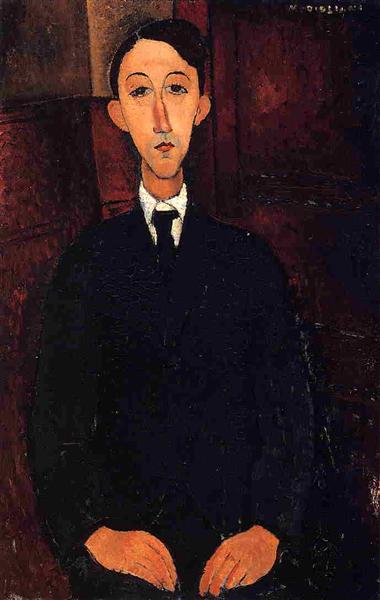Description
Amedee Modigliani, one of the most emblematic figures of modern art, is known for its distinctive style that combines the simplification of forms with a deep emotional load. The work "Manuel Humberg Esteve" of 1916 is erected as an excellent example of its artistic experiments and its ability to capture the essence of the human being in a framework of elegance and serenity. In this portrait, the artist presents his friend and biographer Manuel Humberg Esteve, a figure that not only had a role in Modigliani's life, but also represented a significant connection within the artistic bohemian of the early twentieth century.
When observing the composition of the work, a clear and stylized organization is perceived. Modigliani uses a warm colored palette, in which terracotta, ocher and ivory tones predominate, which gives a special luminosity to the skin of the portrayed. This particular color treatment is characteristic of the artist, who often managed to bring the viewer closer to an intimate and personal atmosphere, almost as if he was invited to share a private moment with the subject. The way in which tones are combined creates a softness that highlights the figure in the center of the composition, with a simple background that does not compete with the protagonist, allowing his presence to occupy all the attention.
The face of Manuel Humberg, stylized and elongated, is part of the characteristic style of Modigliani, which departs from the traditional norms of the portrait. The eyes, large and expressive, seem to be fixing an intense look, counteracted by the delicacy of the line that draws his lips. The neck length, another distinctive feature of Modigliani, provides an almost sculptural elegance to the figure. In addition, a head treatment is observed that reflects both the intimacy and vulnerability of the subject, calling contemplation.
The work is not just a portrait in the conventional sense; It is an exploration of being, an attempt to capture Humberg's individuality in an instant. Modigliani, often considered a master Of the modern portrait, it achieves in this painting to infuse its model a uniqueness that translates into a dialogue between the spectator and the work. The figures that Modigliani creates tend to awaken a feeling of nostalgia, as well as a longing for moments that are fleeting, and "Manuel Humberg Esteve" is no exception.
The historical context of the creation of this work lies in a time of profound artistic changes, in which Modigliani was immersed in a vibrant artistic community in Paris. The influence of African art and Renaissance art are frequently cited as elements that enrich their style, which manifests itself with the same force in this work. In "Manuel Humberg Esteve", this crossing of influences can be glimpsed, especially in the stylization of the figure and the line, which reinterprets aspects of sculpture through painting.
In addition, it is interesting to consider that, although the portrait is central, it is also located within the evolution of Modigliani himself. In 1916, Modigliani was at a crucial moment of his career, developing and refining the characteristics that define it and separate him from his contemporaries.
In short, "Manuel Humberg Esteve" is more than a simple representation; It is a fusion of drawing, painting and emotion. Modigliani, through his mastery, offers us a look at an individual, his relationships and the atmosphere of his time, transforming a moment into an eternal piece of art that resonates with those who seek to understand the depth of being. The work highlights the unique artistic voice of Modigliani, echoing not only as a portrait of a man, but as an echo in the time of the human spirit.
KUADROS ©, a famous paint on your wall.
Reproductions of paintings handmade oil, with the quality of professional artists and the distinctive seal of KUADROS ©.
Art reproduction service with satisfaction guarantee. If you are not completely satisfied with the replica of your painting, we refund your money 100%.

